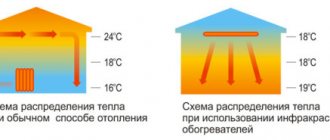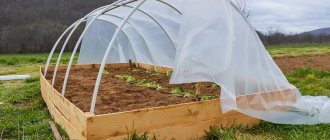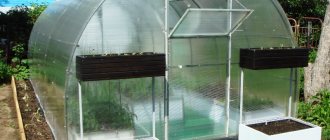When constructing and planning a site, it is necessary to take into account the standards for the placement of structures from fences and buildings. There are standards indicating at what distance the greenhouse should be from the fence and the house. We must not forget about the shadow falling on the neighboring site, so that the building does not have to be demolished. By following the rules, you can use every piece of land with maximum efficiency, without violating the interests of your neighbors according to the law.
Polycarbonate greenhouse on a garden plot
Legislative standards for greenhouse construction
Like other construction projects, greenhouse construction standards are regulated by:
- SNiP 30-02-97;
- SP 30-102-99.
According to the law, the classification of a greenhouse depends on the materials of construction. If it is wooden or made of polycarbonate, we are talking about an outbuilding, and if it is covered with film, it is a temporary structure without a foundation. The latter are not included in the site plan, which is registered in the BTI.
Rules that must be followed when installing a greenhouse:
- does not interfere with the optimal use of useful land;
- does not cause sewage to enter the neighboring area;
- does not create a shadow on someone else's territory.
In the latter case, it is necessary to provide a sufficient amount of sunlight for the neighboring site. In autumn and spring, sun access should be at least 5 hours a day. If this condition is not met, the greenhouse must be moved further from the border or made lower. Another option for solving this issue is to install a transparent roof that will not block sunlight.
It should also be taken into account that for fire safety purposes, a free passage of at least 1 meter must be provided around the building, and the distance to the neighboring building is 6 meters if it is made of brick or other non-combustible material and 12 meters if it is wooden.
Shade-tolerant vegetables for the garden
On any garden plot there are problem areas that are illuminated by the Sun for several hours or are shaded by fruit trees, buildings or fences.
For some types of vegetables and herbs, this illumination will be quite sufficient. A number of vegetable crops grow even better in the shade than in sunny areas. Shade-tolerant vegetable crops will help solve the issue of maximizing the use of garden space so that all areas in the shade or where light is diffused are used.
However, it is worth knowing that vegetable crops grown for roots or fruits must grow in full sun. If you want to get a harvest of leaves, you can use places in partial shade. Please note, not a single plant can survive without the Sun. It is also worth noting that the shadow in the warm regions of the country is very different from that in the center, and even more so in the north. When planning planting in the shade, you must take into account climatic conditions. In the southern regions, tomatoes, zucchini and cucumbers grow well in partial shade. The lack of sun will slightly delay the ripening period, but will not affect their taste and size.
Where there is no stable warm summer, plants planted in dense shade develop poorly. You should not count on a large harvest. In cold and rainy weather, due to lack of light, mold, mushrooms can form, and a large number of slugs and snails appear. Therefore, to obtain a good harvest of root crops, you still need to plant vegetable crops in sunny areas.
At what distance to place the greenhouse?
Building codes specify only the recommended distance between the greenhouse and other objects; the final distance depends on whether the requirements for the absence of shade and drainage on the adjacent property are met.
According to clause 6.8 of SNiP, the distance from the greenhouse to:
- residential building, cellar, latrine or outbuilding for keeping small livestock and poultry - 12 meters;
- shower, baths or saunas - 8 meters;
- to the fence of the neighboring plot - 1 meter.
You can violate these standards by written agreement with your neighbor. But it is important to take into account that the term of such an agreement is 3 years or until the owner of the site changes. This means that even if a neighbor agrees that you reduce the distance from the greenhouse to his territory, there is no guarantee that he will not soon sell the land or it will not be inherited by someone.
To eliminate the risk of receiving a fine and a dismantling order, it is better to install the greenhouse taking into account the recommended distances. It should be taken into account that reducing the distance to the fence does not provide any significant savings in land, so it is better to install the greenhouse no closer than a meter to the fence. In the area between the building and the fence, you can plant shade-loving plants that will protect the crop from the scorching sun on the south side and will absorb water flowing down the fence after rain.
What should be the distance from the garage to the neighbors fence
How much should you set back from the fence when building a house?
✅ Rules for SNT
If the land plot is located on the territory of garden non-profit partnerships, dacha communities and cooperatives, then the basic rules for the placement of residential and outbuildings are prescribed in the internal documentation of the communities - charters of SNT, DNA, etc.
When joining a dacha or garden cooperative (when purchasing land), the board must familiarize each new member of the community with the charter and hand over a copy of the document.
Internal standards regulating the construction of structures on the territory of SNT are based on the requirements of the listed SNiPs, but may have differences, since official documents are advisory in nature. The charters of individual communities contain clauses prohibiting the independent construction of outbuildings or requiring approval of the construction of greenhouses and sheds from the board. In gardening partnerships there are restrictions on keeping birds and livestock, and in dacha cooperatives - on the size and total area of greenhouses, the distance of farm structures from water bodies, etc. Therefore, before constructing a structure, it is necessary to study the local regulations. If there are no restrictions, the facility is built in accordance with the standards SNiP 21-01-97*, SNiP 2.07.01-89* and SP 42.13330.2011.
Expert opinion
Dmitry Nosikov
Lawyer. Specialization: family and housing law.
Many summer residents do not agree with both the terms of the official regulations and the rules prescribed in the charter of the cooperative, since it is not always possible to comply with the recommended parameters on “6-8 acres”. To resolve controversial issues, you should contact the local administration, where they will provide the necessary documentation or give recommendations on the correct location of outbuildings. As a last resort, dacha owners have the right to go to court.
Land plots of non-profit partnerships, as a rule, are built up with seasonal houses and are often not provided with heating, water and electricity. The red line is not respected in this case. Therefore, you can determine at what distance to install the greenhouse based on the location of the road in front and on the side of the lane. The greenhouse is placed at a distance no closer than:
- 1 m from the fence;
- 5 m from the line of the asphalt road or curb;
- 3 m from the sidewalk or dirt road.
In cases where you cannot independently determine what distance to your neighbor’s fence should be maintained, you must contact the board of the cooperative for clarification.











